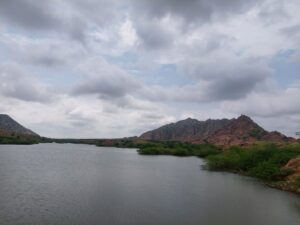by Abdul Waheed Bhutto 3 August 2023
Nestled in Pakistan’s Sindh province, Tharparkar is a land of diverse communities, surrounded by the vast Thar Desert. This region offers a paradise-like experience to visitors, allowing them to immerse themselves in the indigenous cultures, traditions, and unique lifestyles of the Thari people. At the heart of Tharparkar lies the majestic Karoonjhar, also known as the Karoonjhar Mountains or Nagarparkar Hill, spanning approximately 16 kilometers in length and 8 kilometers in width. These hills hold immense historical, religious, and cultural significance that dates back centuries, with a rich heritage left behind by various civilizations and dynasties.
For the Hindu community, Karoonjhar is of profound religious importance, as it houses several Hindu holy temples revered for their religious and cultural significance. Devotees and pilgrims from far and wide flock to temples such as the Shiv Mandir in Umerkot, dedicated to Lord Shiva, and the Kaloi Mandir in Nagarparkar, dedicated to Goddess Kali. The region is also home to ancient Jain temples, Hanuman Mandir, Shri Varun Dev Mandir in Mithi, Gorakhnath Mandir, Shri Laxminarayan Mandir in Islamkot, and Rama Pir Mandir in Chelhar. These temples not only serve as places of worship but also as centers of community gatherings and cultural exchange, reflecting the deep-rooted religious and cultural heritage of Tharparkar’s Hindu population.
Similarly, several notable Muslim historical sites in Karoonjhar hold significant religious and cultural importance. The Khawaja Khizir Tomb in the village of Samaro serves as a place of spiritual devotion and pilgrimage for Muslims, while the Bhodesar Mosque in Tharparkar showcases unique architectural features and historical significance. The Naukot Fort, believed to have been constructed by Mir Karam Ali Khan Talpur in 1814 AD, provides insights into the region’s historical military and architectural heritage. Additionally, the Gori temple northwest of Viravah reflects the region’s cultural and religious diversity, despite bearing the effects of fire and gunpowder damage from the Nagar outbreak. The archaeological heritage of Karoonjhar Hills provides valuable insights into past human habitation and cultural evolution.
Apart from its cultural treasures, Tharparkar boasts a vibrant folk music tradition, especially Sufi music, celebrated by local musicians and singers during folk festivals and melas. Despite its arid environment, Karoonjhar Hill supports a diverse range of biodiversity, including various plant and animal species adapted to desert conditions, making it an attractive tourist destination for visitors from Pakistan and beyond.
However, beneath its picturesque exterior, Tharparkar faces social welfare challenges, including education, healthcare, and employment issues. Limited access to quality education, particularly in remote areas, results in high dropout rates and low literacy levels, especially among girls. Inadequate healthcare facilities lead to health disparities, with malnutrition, waterborne diseases, and infant mortality posing significant concerns. The region’s economy, heavily dependent on agriculture and livestock, struggles with a shortage of employment opportunities and a high unemployment rate.
Moreover, the people of Tharparkar grapple with food and water scarcity. The arid region’s limited rainfall makes it challenging for local farmers to sustain their livelihoods, leading to food shortages and malnutrition, especially among vulnerable populations. Additionally, access to clean and safe drinking water remains a major concern due to scarce and unreliable natural water sources, exacerbating health risks. Despite the strategic construction of several small dams in certain areas of the Karoonjhar mountain range to mitigate water scarcity, their impact has been limited.
Compounding the existing challenges, Thar coal mining and the establishment of power plants in the Thar Desert region have raised serious environmental concerns. While the primary aim of these projects is to enhance the country’s energy production and reduce dependency on imports, they come with significant environmental consequences. The process of land clearance for mining and plant construction has resulted in deforestation and habitat destruction, posing a threat to the local flora and fauna. Moreover, the operation of coal-fired power plants leads to the release of harmful emissions such as sulfur dioxide and nitrogen oxides, which adversely affect air quality and public health. Additionally, these activities contribute to land degradation and increase the risks associated with climate change. Furthermore, the traditional practices and livelihoods of indigenous communities in the area have been impacted by these developments.
Despite profiting from these operations, there have been complaints that the company is not adequately contributing to the social welfare of the local people. The lack of significant investment in the community has left the local population without proper benefits or support.
Moreover, the neglect of historical sites in the region is evident, with little to no efforts being made for their restoration and preservation. This situation has sparked discontent among locals who value their cultural heritage and history.
To address these issues, it is crucial for the company to take responsibility for the environmental consequences of its operations and actively invest in the well-being of the local population, including the restoration and preservation of historical sites for the benefit of the community and the region as a whole.
Tharparkar, holds significant solar energy potential due to its strategic location within the sun-drenched Thar Desert. The region benefits from abundant sunlight and minimal cloud cover throughout the year, making it an ideal site for solar energy harnessing. The flat terrain offers ample space for large-scale solar power projects, and both utility-scale and distributed solar solutions hold promise.
Recently, Tharparkar has witnessed a surge in controversies concerning granite mining, which has evoked widespread public outcry and led to protests, compelling the government to reevaluate its proposals. The matter of granite mining came to the forefront after an advertisement for an open auction of a granite mining lease in Nanagarparkar, Tharparkar district, was published in newspapers on July 22 and 23, 2023, triggering strong opposition. Due to the vehement protests led by nationalist parties, the Sindh government eventually abandoned its plans to auction the lease in the Karoonjhar Mountains.
The focus on preserving Karoonjhar’s heritage remains crucial, as it serves as a testament to the rich religious, cultural, and social fabrics of Tharparkar. Concerted efforts from the government, NGOs, and the private sector are required to address socioeconomic issues and protect the region’s natural heritage. Stringent regulations, sustainable alternatives, and renewable energy investments can help mitigate the consequences of mining activities.
In conclusion, the majestic Karoonjhar mountain stands as a testament to the rich heritage and cultural significance of Tharparkar. Its temples, music, festivals, and unique geological features contribute to the region’s diverse and vibrant identity. Preserving these treasures and addressing social welfare challenges will enable Tharparkar to continue welcoming visitors, offering them an opportunity to explore the enchanting beauty and heritage of this extraordinary land.
Moreover, Tharparkar’s potential for harnessing solar energy holds great promise for Pakistan’s sustainable future. With abundant sunlight and a sun-drenched landscape, the region boasts significant solar energy potential. Embracing renewable energy can reduce fossil fuel dependence, mitigate emissions, enhance energy security, and foster economic growth. However, realizing this potential requires substantial investments in infrastructure, technology, and supportive policies.
The local communities are fervently urging the Sindh government to grant the status of national heritage to Karoonjhar mountain, ensuring its preservation and appreciation for generations to come. By taking these steps, Tharparkar can pave the way towards a greener and brighter future for Pakistan, while maintaining its unique cultural legacy and ecological splendor.


